TOYOTA VERSO S 2014 Owners Manual
Manufacturer: TOYOTA, Model Year: 2014, Model line: VERSO S, Model: TOYOTA VERSO S 2014Pages: 560, PDF Size: 16.94 MB
Page 251 of 560
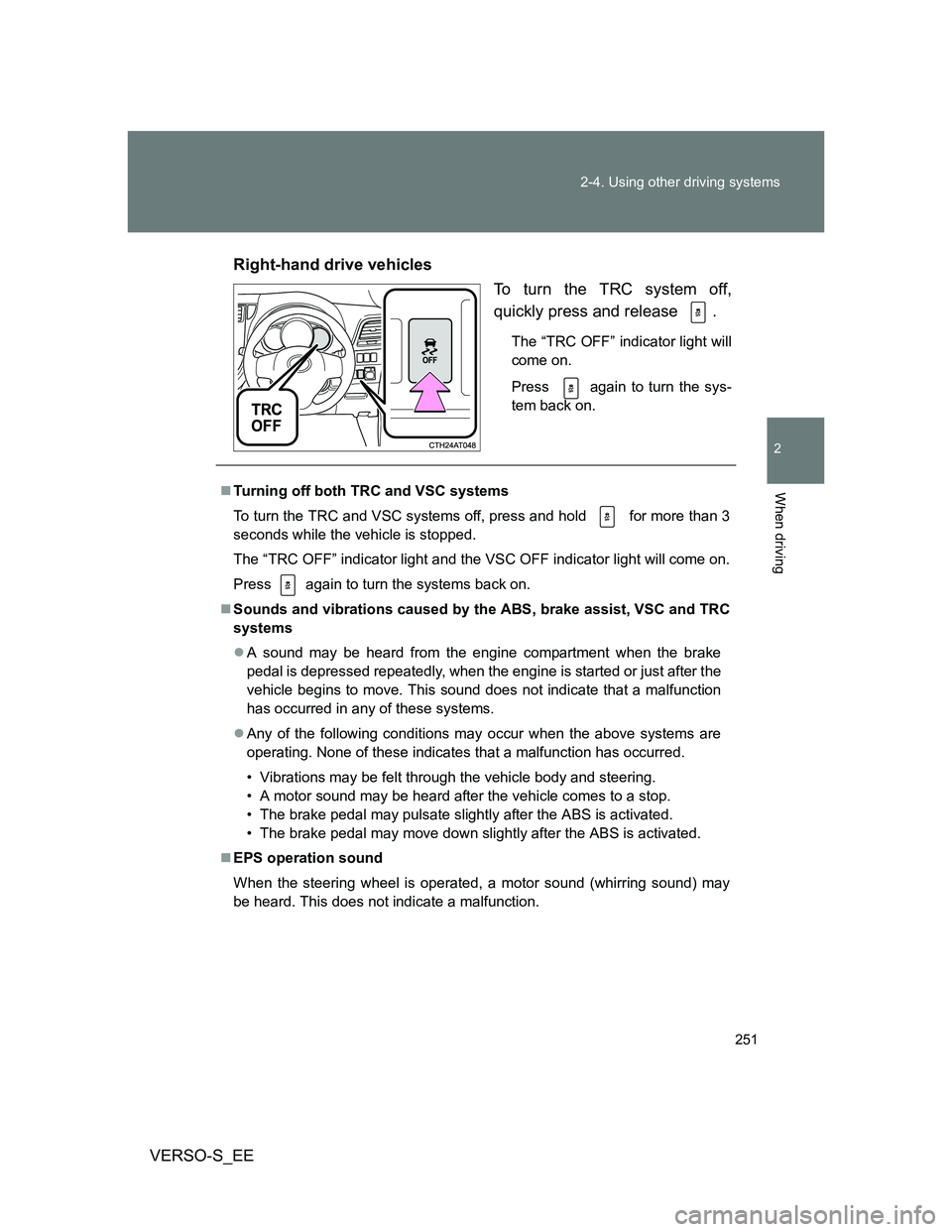
251 2-4. Using other driving systems
2
When driving
VERSO-S_EERight-hand drive vehicles
To turn the TRC system off,
quickly press and release
.
The ŌĆ£TRC OFFŌĆØ indicator light will
come on.
Press
again to turn the sys-
tem back on.
’ü«Turning off both TRC and VSC systems
To turn the TRC and VSC systems off, press and hold
for more than 3
seconds while the vehicle is stopped.
The ŌĆ£TRC OFFŌĆØ indicator light and the VSC OFF indicator light will come on.
Press again to turn the systems back on.
’ü«Sounds and vibrations caused by the ABS, brake assist, VSC and TRC
systems
’ü¼A sound may be heard from the engine compartment when the brake
pedal is depressed repeatedly, when the engine is started or just after the
vehicle begins to move. This sound does not indicate that a malfunction
has occurred in any of these systems.
’ü¼Any of the following conditions may occur when the above systems are
operating. None of these indicates that a malfunction has occurred.
ŌĆó Vibrations may be felt through the vehicle body and steering.
ŌĆó A motor sound may be heard after the vehicle comes to a stop.
ŌĆó The brake pedal may pulsate slightly after the ABS is activated.
ŌĆó The brake pedal may move down slightly after the ABS is activated.
’ü«EPS operation sound
When the steering wheel is operated, a motor sound (whirring sound) may
be heard. This does not indicate a malfunction.
Page 252 of 560
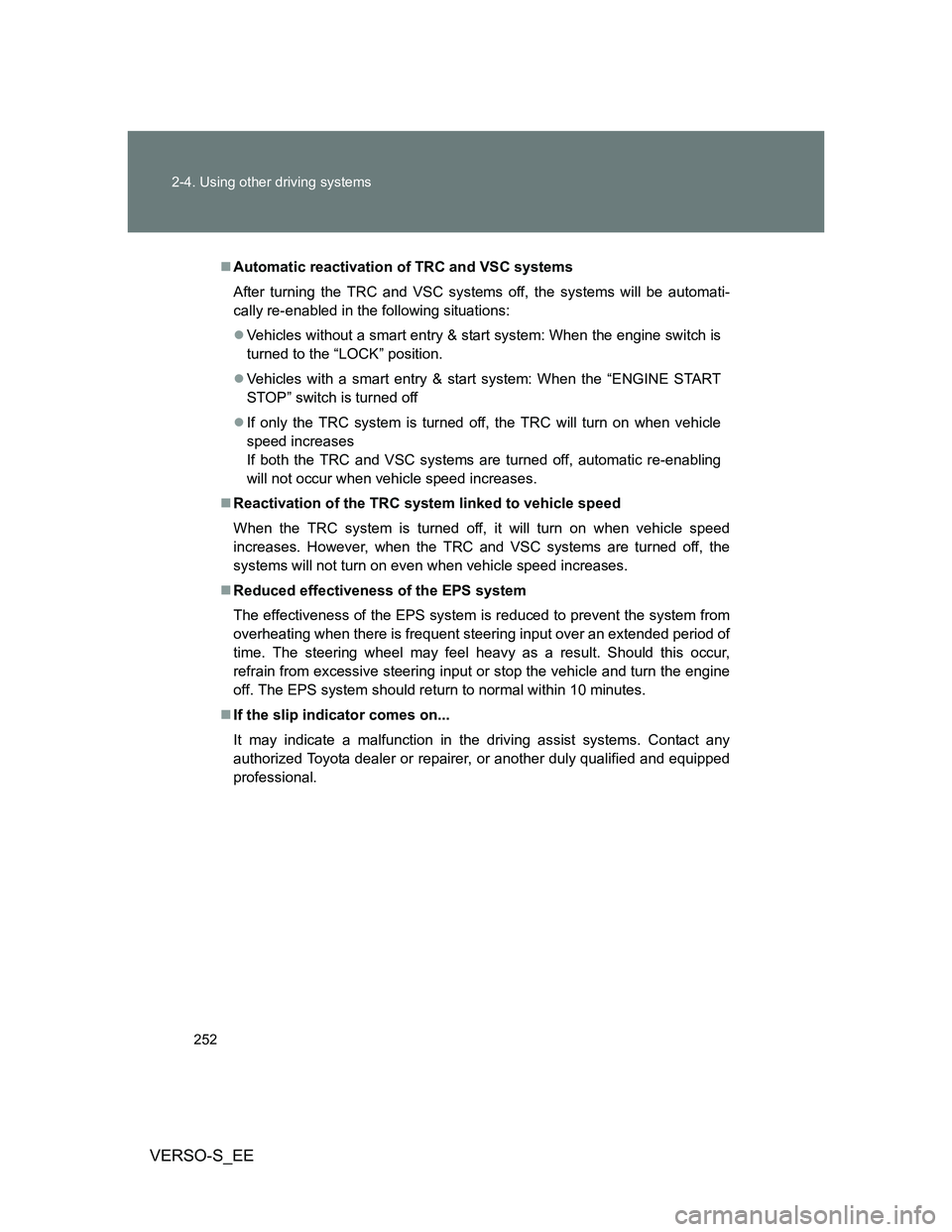
252 2-4. Using other driving systems
VERSO-S_EE
’ü«Automatic reactivation of TRC and VSC systems
After turning the TRC and VSC systems off, the systems will be automati-
cally re-enabled in the following situations:
’ü¼Vehicles without a smart entry & start system: When the engine switch is
turned to the ŌĆ£LOCKŌĆØ position.
’ü¼Vehicles with a smart entry & start system: When the ŌĆ£ENGINE START
STOPŌĆØ switch is turned off
’ü¼If only the TRC system is turned off, the TRC will turn on when vehicle
speed increases
If both the TRC and VSC systems are turned off, automatic re-enabling
will not occur when vehicle speed increases.
’ü«Reactivation of the TRC system linked to vehicle speed
When the TRC system is turned off, it will turn on when vehicle speed
increases. However, when the TRC and VSC systems are turned off, the
systems will not turn on even when vehicle speed increases.
’ü«Reduced effectiveness of the EPS system
The effectiveness of the EPS system is reduced to prevent the system from
overheating when there is frequent steering input over an extended period of
time. The steering wheel may feel heavy as a result. Should this occur,
refrain from excessive steering input or stop the vehicle and turn the engine
off. The EPS system should return to normal within 10 minutes.
’ü«If the slip indicator comes on...
It may indicate a malfunction in the driving assist systems. Contact any
authorized Toyota dealer or repairer, or another duly qualified and equipped
professional.
Page 253 of 560
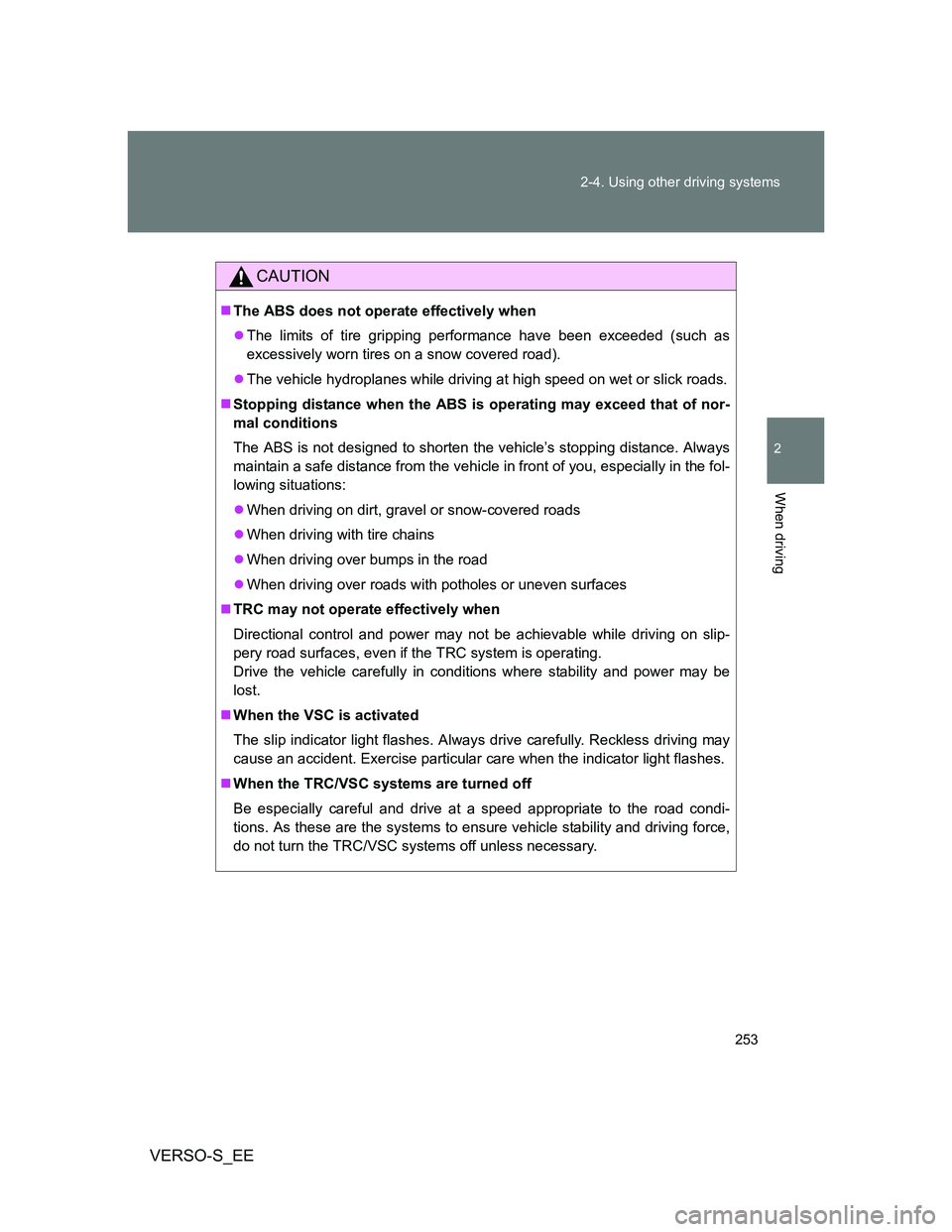
253 2-4. Using other driving systems
2
When driving
VERSO-S_EE
CAUTION
’ü«The ABS does not operate effectively when
’ü¼The limits of tire gripping performance have been exceeded (such as
excessively worn tires on a snow covered road).
’ü¼The vehicle hydroplanes while driving at high speed on wet or slick roads.
’ü«Stopping distance when the ABS is operating may exceed that of nor-
mal conditions
The ABS is not designed to shorten the vehicleŌĆÖs stopping distance. Always
maintain a safe distance from the vehicle in front of you, especially in the fol-
lowing situations:
’ü¼When driving on dirt, gravel or snow-covered roads
’ü¼When driving with tire chains
’ü¼When driving over bumps in the road
’ü¼When driving over roads with potholes or uneven surfaces
’ü«TRC may not operate effectively when
Directional control and power may not be achievable while driving on slip-
pery road surfaces, even if the TRC system is operating.
Drive the vehicle carefully in conditions where stability and power may be
lost.
’ü«When the VSC is activated
The slip indicator light flashes. Always drive carefully. Reckless driving may
cause an accident. Exercise particular care when the indicator light flashes.
’ü«When the TRC/VSC systems are turned off
Be especially careful and drive at a speed appropriate to the road condi-
tions. As these are the systems to ensure vehicle stability and driving force,
do not turn the TRC/VSC systems off unless necessary.
Page 254 of 560
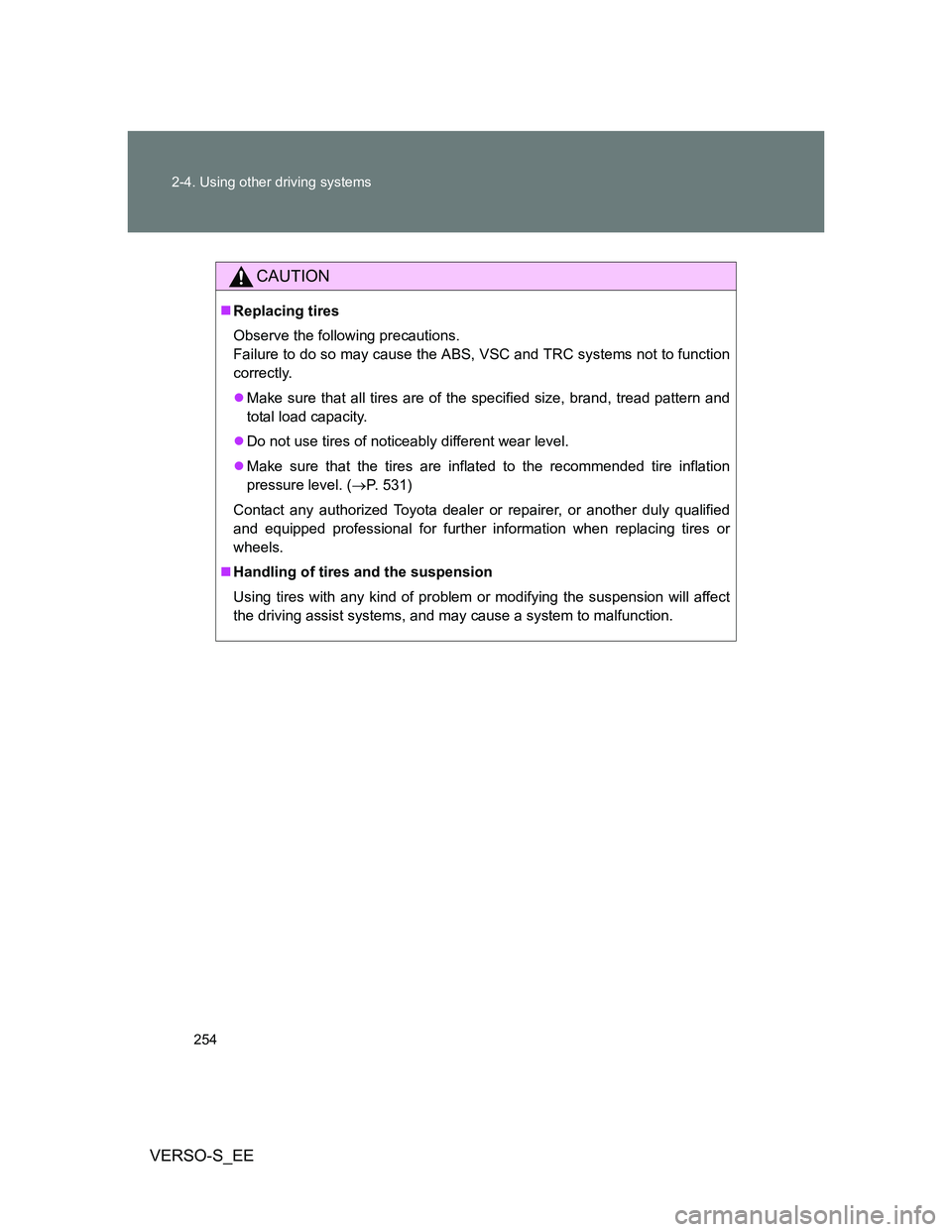
254 2-4. Using other driving systems
VERSO-S_EE
CAUTION
’ü«Replacing tires
Observe the following precautions.
Failure to do so may cause the ABS, VSC and TRC systems not to function
correctly.
’ü¼Make sure that all tires are of the specified size, brand, tread pattern and
total load capacity.
’ü¼Do not use tires of noticeably different wear level.
’ü¼Make sure that the tires are inflated to the recommended tire inflation
pressure level. (’é«P. 531)
Contact any authorized Toyota dealer or repairer, or another duly qualified
and equipped professional for further information when replacing tires or
wheels.
’ü«Handling of tires and the suspension
Using tires with any kind of problem or modifying the suspension will affect
the driving assist systems, and may cause a system to malfunction.
Page 255 of 560
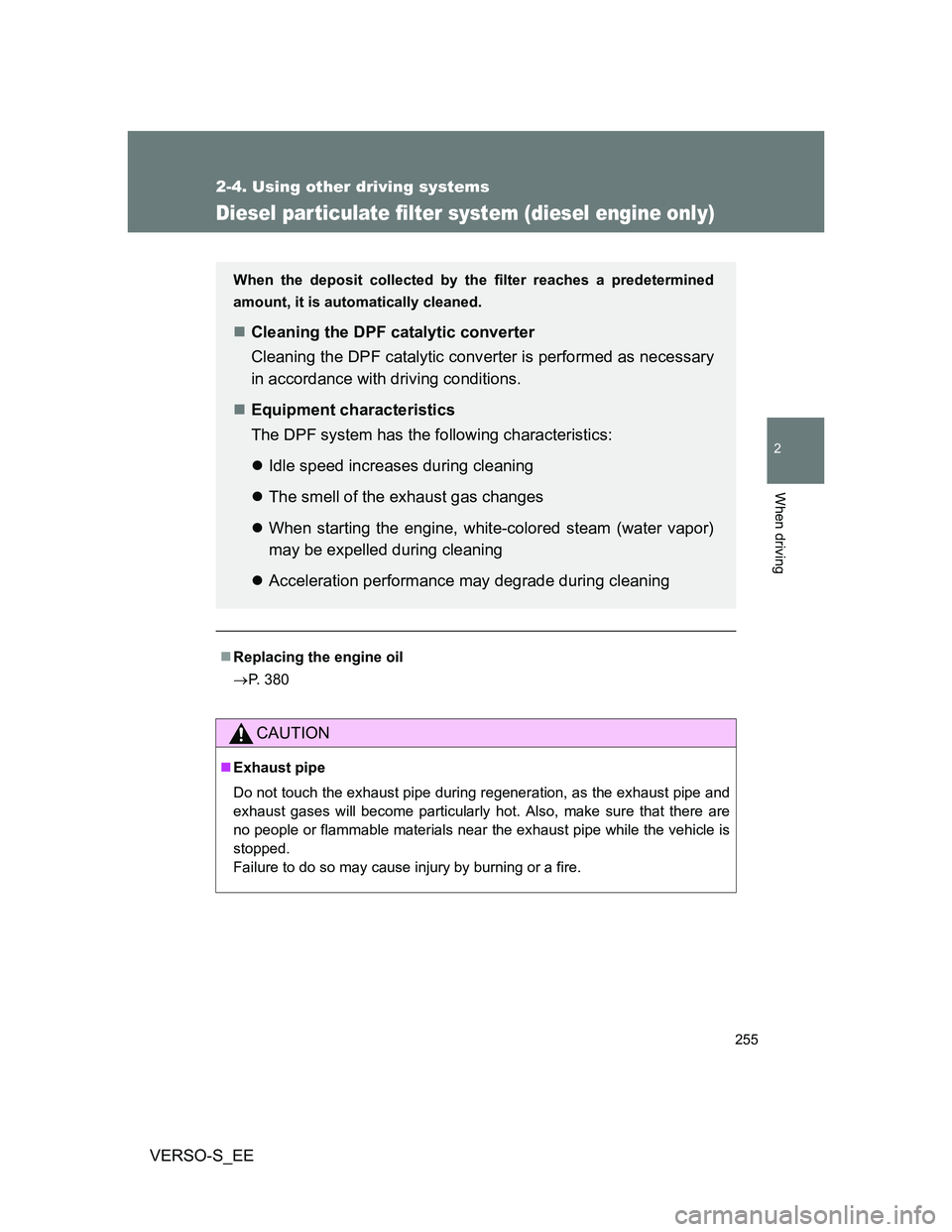
255
2-4. Using other driving systems
2
When driving
VERSO-S_EE
Diesel particulate filter system (diesel engine only)
’ü«Replacing the engine oil
’é«P. 380
CAUTION
’ü«Exhaust pipe
Do not touch the exhaust pipe during regeneration, as the exhaust pipe and
exhaust gases will become particularly hot. Also, make sure that there are
no people or flammable materials near the exhaust pipe while the vehicle is
stopped.
Failure to do so may cause injury by burning or a fire.
When the deposit collected by the filter reaches a predetermined
amount, it is automatically cleaned.
’ü«Cleaning the DPF catalytic converter
Cleaning the DPF catalytic converter is performed as necessary
in accordance with driving conditions.
’ü«Equipment characteristics
The DPF system has the following characteristics:
’ü¼Idle speed increases during cleaning
’ü¼The smell of the exhaust gas changes
’ü¼When starting the engine, white-colored steam (water vapor)
may be expelled during cleaning
’ü¼Acceleration performance may degrade during cleaning
Page 256 of 560
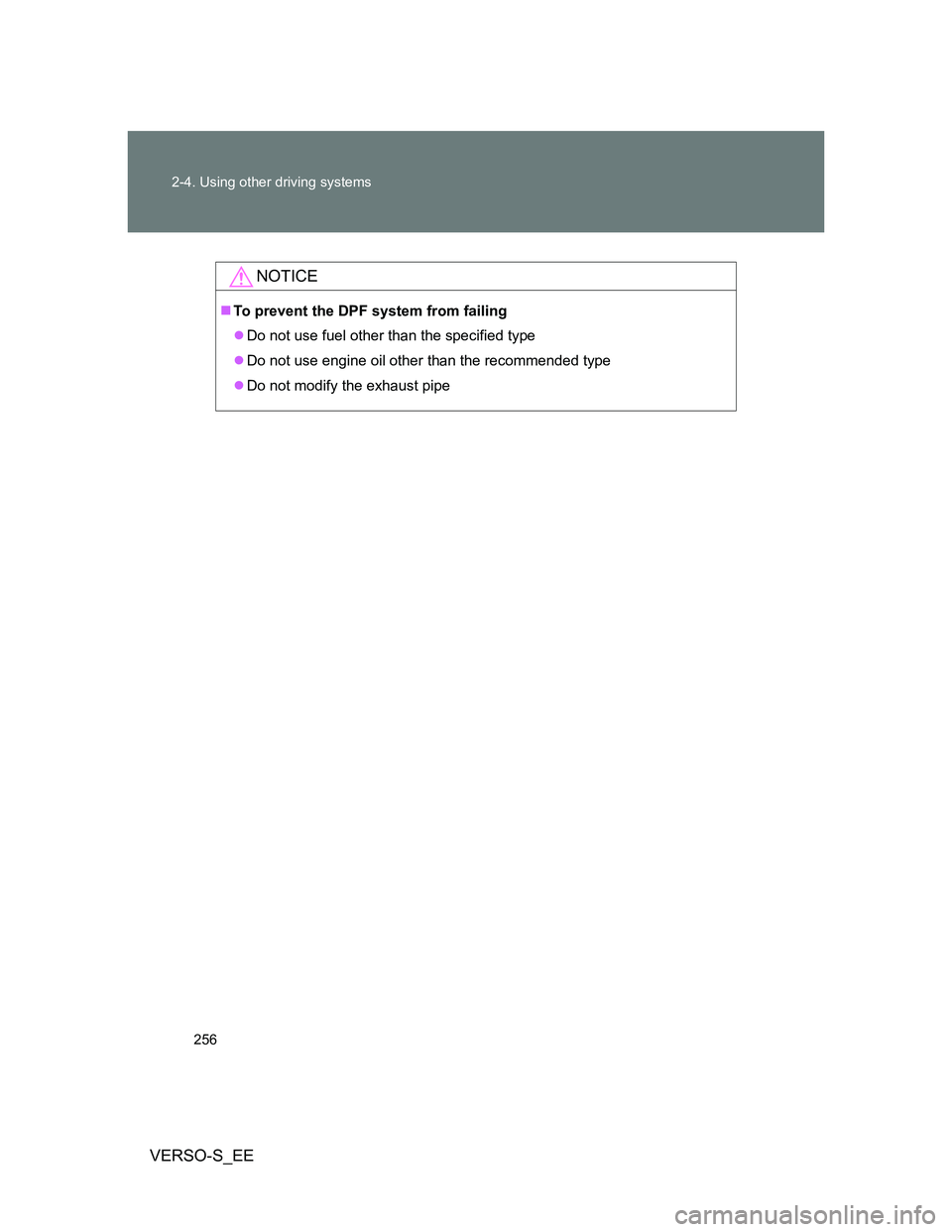
256 2-4. Using other driving systems
VERSO-S_EE
NOTICE
’ü«To prevent the DPF system from failing
’ü¼Do not use fuel other than the specified type
’ü¼Do not use engine oil other than the recommended type
’ü¼Do not modify the exhaust pipe
Page 257 of 560
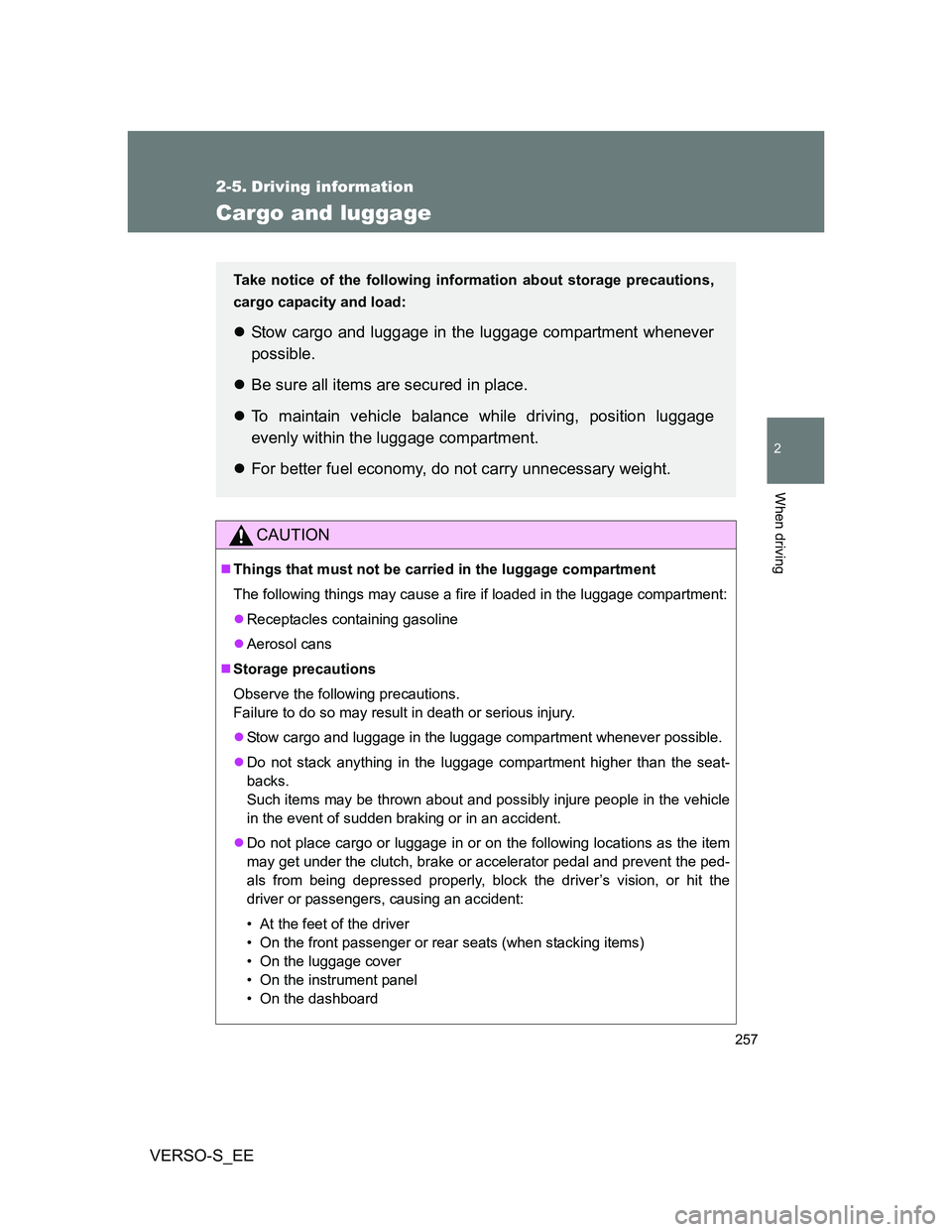
257
2
When driving
VERSO-S_EE
2-5. Driving information
Cargo and luggage
CAUTION
’ü«Things that must not be carried in the luggage compartment
The following things may cause a fire if loaded in the luggage compartment:
’ü¼Receptacles containing gasoline
’ü¼Aerosol cans
’ü«Storage precautions
Observe the following precautions.
Failure to do so may result in death or serious injury.
’ü¼Stow cargo and luggage in the luggage compartment whenever possible.
’ü¼Do not stack anything in the luggage compartment higher than the seat-
backs.
Such items may be thrown about and possibly injure people in the vehicle
in the event of sudden braking or in an accident.
’ü¼Do not place cargo or luggage in or on the following locations as the item
may get under the clutch, brake or accelerator pedal and prevent the ped-
als from being depressed properly, block the driverŌĆÖs vision, or hit the
driver or passengers, causing an accident:
ŌĆó At the feet of the driver
ŌĆó On the front passenger or rear seats (when stacking items)
ŌĆó On the luggage cover
ŌĆó On the instrument panel
ŌĆó On the dashboard
Take notice of the following information about storage precautions,
cargo capacity and load:
’ü¼Stow cargo and luggage in the luggage compartment whenever
possible.
’ü¼Be sure all items are secured in place.
’ü¼To maintain vehicle balance while driving, position luggage
evenly within the luggage compartment.
’ü¼For better fuel economy, do not carry unnecessary weight.
Page 258 of 560
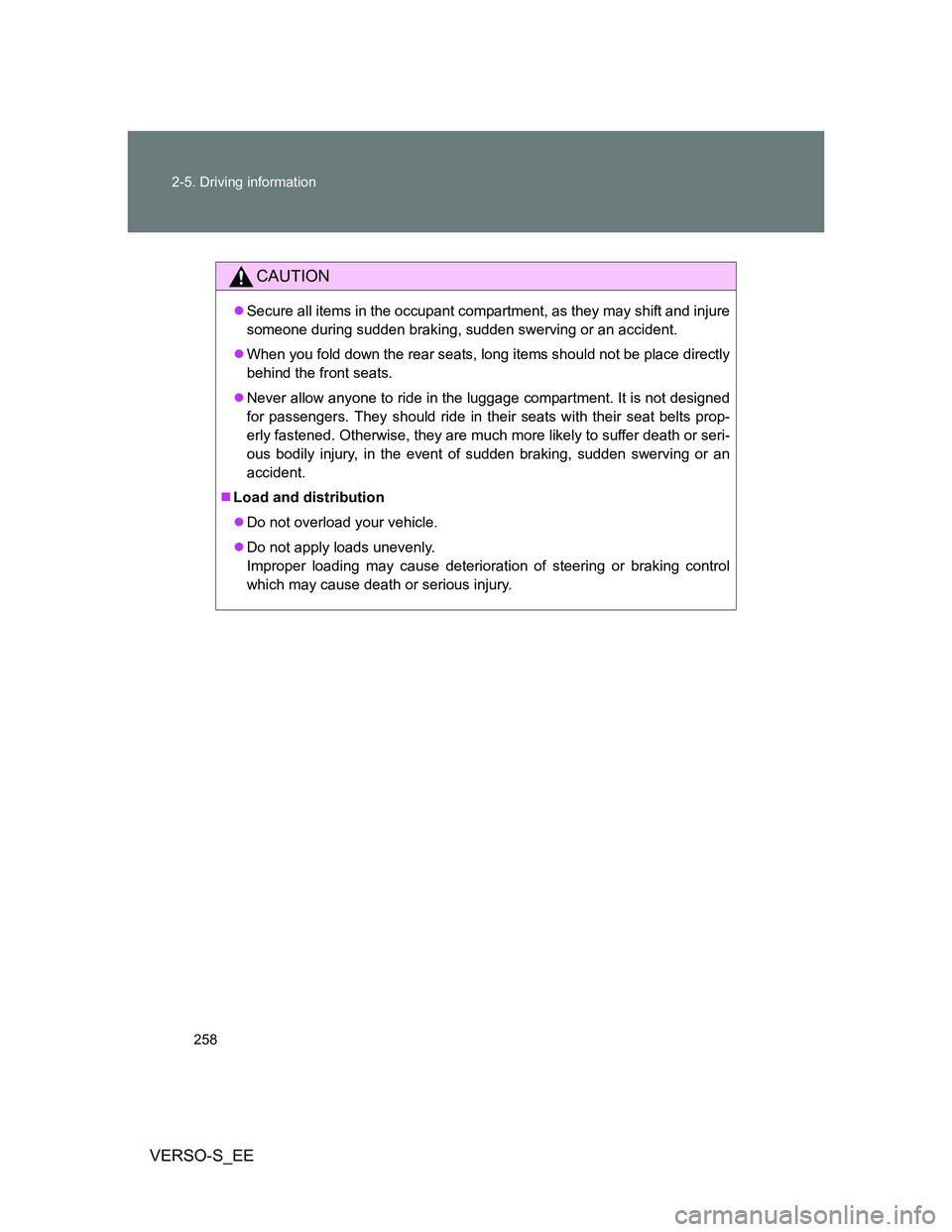
258 2-5. Driving information
VERSO-S_EE
CAUTION
’ü¼Secure all items in the occupant compartment, as they may shift and injure
someone during sudden braking, sudden swerving or an accident.
’ü¼When you fold down the rear seats, long items should not be place directly
behind the front seats.
’ü¼Never allow anyone to ride in the luggage compartment. It is not designed
for passengers. They should ride in their seats with their seat belts prop-
erly fastened. Otherwise, they are much more likely to suffer death or seri-
ous bodily injury, in the event of sudden braking, sudden swerving or an
accident.
’ü«Load and distribution
’ü¼Do not overload your vehicle.
’ü¼Do not apply loads unevenly.
Improper loading may cause deterioration of steering or braking control
which may cause death or serious injury.
Page 259 of 560
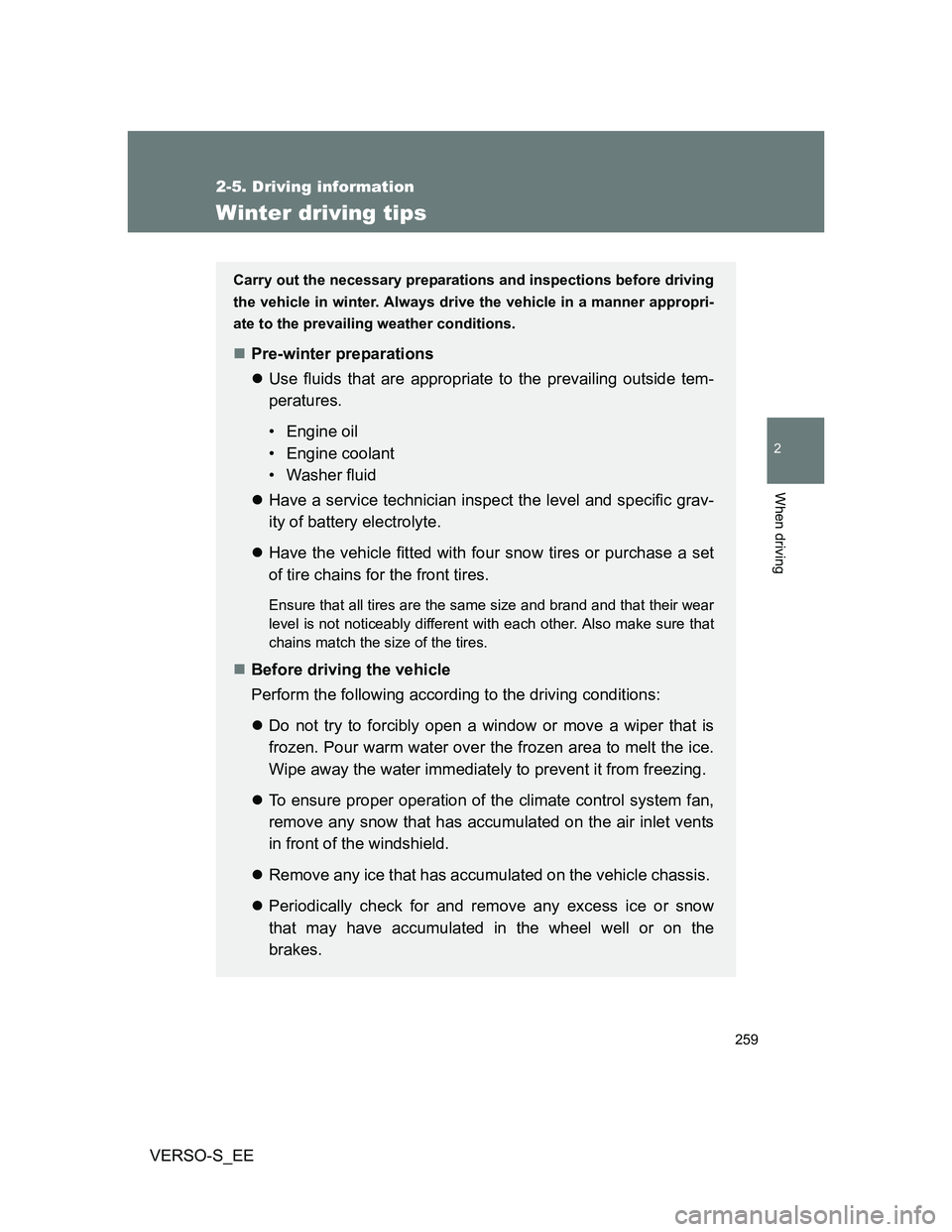
259
2-5. Driving information
2
When driving
VERSO-S_EE
Winter driving tips
Carry out the necessary preparations and inspections before driving
the vehicle in winter. Always drive the vehicle in a manner appropri-
ate to the prevailing weather conditions.
’ü«Pre-winter preparations
’ü¼Use fluids that are appropriate to the prevailing outside tem-
peratures.
ŌĆó Engine oil
ŌĆó Engine coolant
ŌĆó Washer fluid
’ü¼Have a service technician inspect the level and specific grav-
ity of battery electrolyte.
’ü¼Have the vehicle fitted with four snow tires or purchase a set
of tire chains for the front tires.
Ensure that all tires are the same size and brand and that their wear
level is not noticeably different with each other. Also make sure that
chains match the size of the tires.
’ü«Before driving the vehicle
Perform the following according to the driving conditions:
’ü¼Do not try to forcibly open a window or move a wiper that is
frozen. Pour warm water over the frozen area to melt the ice.
Wipe away the water immediately to prevent it from freezing.
’ü¼To ensure proper operation of the climate control system fan,
remove any snow that has accumulated on the air inlet vents
in front of the windshield.
’ü¼Remove any ice that has accumulated on the vehicle chassis.
’ü¼Periodically check for and remove any excess ice or snow
that may have accumulated in the wheel well or on the
brakes.
Page 260 of 560
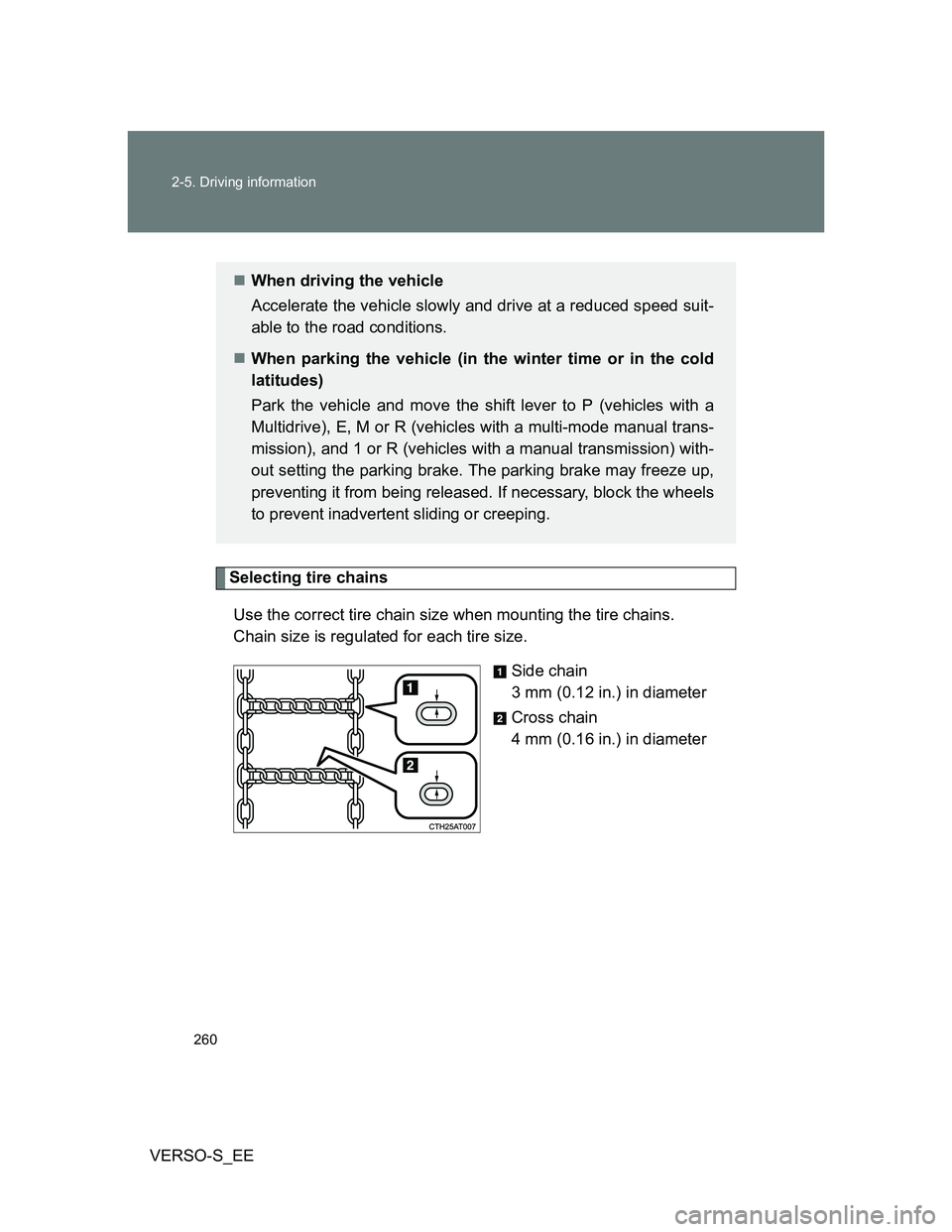
260 2-5. Driving information
VERSO-S_EE
Selecting tire chains
Use the correct tire chain size when mounting the tire chains.
Chain size is regulated for each tire size.
Side chain
3 mm (0.12 in.) in diameter
Cross chain
4 mm (0.16 in.) in diameter
’ü«When driving the vehicle
Accelerate the vehicle slowly and drive at a reduced speed suit-
able to the road conditions.
’ü«When parking the vehicle (in the winter time or in the cold
latitudes)
Park the vehicle and move the shift lever to P (vehicles with a
Multidrive), E, M or R (vehicles with a multi-mode manual trans-
mission), and 1 or R (vehicles with a manual transmission) with-
out setting the parking brake. The parking brake may freeze up,
preventing it from being released. If necessary, block the wheels
to prevent inadvertent sliding or creeping.